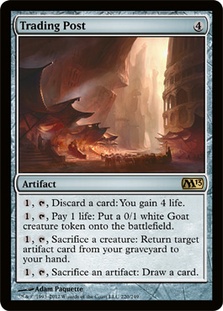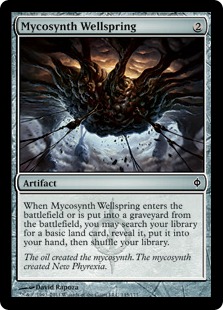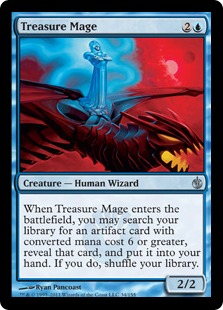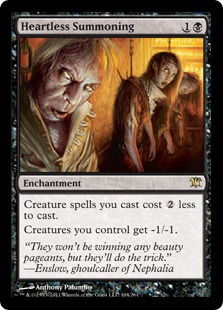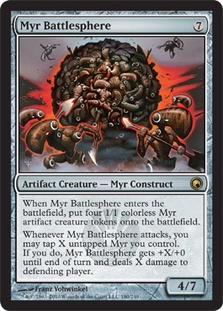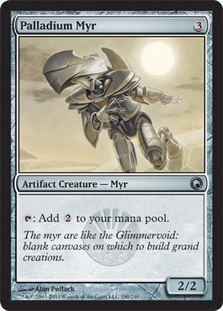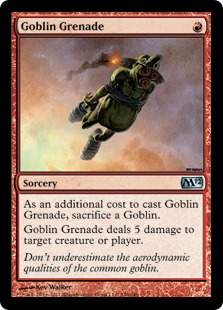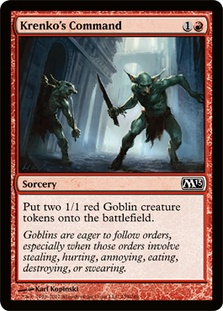“I completely forgot about Smallpox. I am shocked it has seen essentially zero play.” —Ari Lax, voicing his thoughts on my previous article and writing the only grammatically correct sentence in this one
There are just six weeks until rotation. You won’t get such a good chance to try as many interesting ideas in Standard for a while, so today I’m going to draw your attention to some cards that are worth trying at FNM or even at the StarCityGames.com Standard Open in Denver.
Why do some cards see Constructed play and others don’t? The simplest answer is, “Because not all cards were created equal,” but it’s not the best one. The Titans outclassed many aggressive cards during the last two years (like Fauna Shaman and Vengevine), while Caw-Blade and Delver decks outclassed the rest, ensuring that the actual pool of playable cards was as small as possible. Many good and interesting cards just had a Vapor Snag between them and playability.
Also, established archetypes are rewarding for good players, who can spend less effort on breaking the top deck’s mirror match than creating a brand new deck. Do you remember how Kyle Sanchez broke Colfenor’s Plans in Cruel Control a week or two before rotation? That was possible simply because nobody except him even looked at the card. It’s sad but true: it’s insufficient to just create a list and play it (or even make Top 8 of a GP). Every deck requires a lot of care and adjustment from week to week to stay viable, so many potent creations end up being one-shot decks.
I’ve navigated through four spoilers (M12 and Scars block) and created the list of nearly twenty interesting cards that should get some love before rotation. Scars of Mirrodin block was artifact-themed, so there are some engines that work with artifacts. Non-metalcraft ones are typically more interesting because they are much easier to get working.
Tezzeret, Agent of Bolas sees some play in Modern and Legacy (mostly in Affinity decks), but it was never that good in Standard. In my previously article, I mentioned Smallpox’s inability to win due to its slow grind; one can’t simply leave a creature-based deck without resources because any Thragtusk or Blade Splicer plus Birthing Pod may ruin your carefully built defense. Control just can’t be good in the world where card advantage doesn’t matter, especially when good portion of its card are artifacts (which are rarely good card draw or removal).
Two of the most successful attempts with Tezzeret, Agent of Bolas were Patrick Chapin Grixis deck from the Top 8 of Pro Tour Paris and a series of decks by Shouta Yasooka (who is probably biggest Tezzeret enthusiast in the world).
Creatures (2)
Planeswalkers (7)
Lands (22)
Spells (29)

Patrick’s deck is well known, and I highly recommend reading his tournament report, if only to remember why this man deserves to be in the Hall of Fame.
Shouta Yasooka was successful with Tezzeret many times, both during Caw-Blade era and in Scars-Innistrad Standard. His lists were U/B Control decks using Tezzeret as a Tutor for powerful cards like Batterskull, Grafdigger’s Cage, Torpor Orb, etc. When you have a Jace, the Mind Sculptor whose Brainstorm ability works only for artifacts, having Ratchet Bomb instead of Pyroclasm is actually good idea. Nevertheless, Shouta’s pets were never popular because playing other decks was simply more rewarding.
Creatures (8)
Planeswalkers (6)
Lands (24)
Spells (22)
- 1 Doom Blade
- 1 Tumble Magnet
- 4 Ratchet Bomb
- 2 Sphere of the Suns
- 2 Black Sun's Zenith
- 1 Go for the Throat
- 1 Batterskull
- 2 Despise
- 2 Curse of Death's Hold
- 2 Grafdigger's Cage
- 4 Tragic Slip
Sideboard

The problem with Tezzeret decks is that they require some strong backup to ensure that they can work without their namesake. For example, Chapin’s deck had Jace, the Mind Sculptor. I personally liked burn-based Tezzeret attempts built by some members of our community for Standard and Block Constructed. Tezzeret’s ultimate is very powerful, so a Galvanic Blast and Throne of Geth based proliferate engine would make it realistic.
Druidic Satchel is a card that is a Mike Flores favorite, another victim of card advantage’s weakness in format, and a good example of Magic’s design progress from Magic 2012 to Magic 2013. Remember lifelink, Giant Spider, Benalish Veteran, Goblin Piker, etc.? They became Mark of the Vampire, Sentinel Spider, Attended Knight, Mogg Flunkies—much more powerful cards (yay playable aura!) which make M13 Limited a very interesting format.
In the same vein, Druidic Satchel was upgraded to Trading Post in M13. Post is much more powerful in both Limited and Constructed and is a good “build around me” card. I’m not sure that it will remain Standard playable after Mycosynth Wellspring rotates, so now is the perfect time to play a Trading Post deck as it’s also a long-expected backup advantage engine for Tezzeret, Agent of Bolas.
Creatures (4)
Planeswalkers (6)
Lands (24)
Spells (26)

This is a U/B attempt by Brazilian player Willy Edel. Like Shouta Yasooka’s decks, this one is not artifact-centric and uses Tezzeret as a multifunctional Tutor for acceleration, removal, and card drawing and Trading Post to gain value and reuse artifacts (that’s why only two Trading Posts is fine in this list). While this is interesting attempt, I would prefer to go deeper, so let’s look at my Grixis Tezzeret deck.
Creatures (4)
Planeswalkers (4)
Lands (23)
Spells (29)

I desperately wanted to include some proliferate in the deck, but I finally realized that protecting Tezzeret is a better idea than playing weak situational cards. Trading Post gives the deck some versatility and confidence that you’ll have enough cards, enough life, and enough blockers to protect Tezzeret (who is still the main win condition and universal Tutor).
Treasure Mage is a part of the Tezzeret deck puzzle. He is often used as a singleton to double the virtual count of Wurmcoil Engine, Mindslaver, Staff of Nin, and other powerful things. Too bad Mage is unable to find Trading Post, Stuffy Doll, and Batterskull, but he’s already good enough to see more play than he was before, especially in combination with another non-respected sleeper: Grand Architect.
Shockingly, Nick Spagnolo deck (which carried Brad Nelson to the finals of Grand Prix Minneapolis) didn’t include any Treasure Mage, maximizing the Wurmcoil Engine count instead. But as I dislike decks that rely on a single card, my Grand Architect must have a backup in the form of Heartless Summoning (which makes Treasure Mage insane, especially when you’re able to play Wurmcoil Engine on turn 3).
Creatures (25)
- 3 Solemn Simulacrum
- 3 Wurmcoil Engine
- 4 Grand Architect
- 1 Perilous Myr
- 4 Treasure Mage
- 4 Phyrexian Metamorph
- 4 Myr Superion
- 2 Havengul Lich
Lands (23)
Spells (12)

I like this deck very much because it’s extremely fun to play. Of course, you must be fine with being unable to win from time to time—when your best play is Phyrexian Metamorph, your copy of your opponent’s creature will be weaker due to Heartless Summoning. The only M13 addition to the deck is Staff of Nin, which allows you to sideboard into a control-like deck and to have some advantage in long games (where previous versions tended to run out of gas).
Note two more undervalued cards in this list: Myr Superion and Perilous Myr. These creatures are near useless by themselves, but they shine in some combo-like decks that have unfair ways to exploit them, like Heartless Summoning for Superion or Glissa, the Traitor for Perilous Myr. And yes, Glissa is another strong card which didn’t see enough play in the last year. Her last successful appearance on the pro scene was in Conley Woods‘ Grand Prix Orlando-winning Wolf Run Black brew, but in that she was just a good creature with the ability to interact with the singleton Ratchet Bomb. Nevertheless, Glissa is worth building around, and you can see a good example in Bennie Smith recent article.
In fact, there are two more playable Myr creatures: Myr Battlesphere and Palladium Myr. They are powerful as is and fit well into ramp decks, namely Reid Duke Magic Online Worlds-winning Wolf Run Pod and Travis Woo Wolf Run Robots. An additional upside of Myrs is their invulnerability to Whipflare (which is a universally adopted sweeper right now due to its simpler mana cost for decks with ten or more colorless lands), which was used by Travis Woo almost a half year before Glimmerpost became universally adopted. Is Wolf Run Robots worth trying again? I think yes.
Creatures (15)
Lands (26)
Spells (19)

The main difference between this deck and other ramp decks is its mana base. It is built to be sure that every land comes into play untapped so we maximize amount of times we achieve seven mana on time. Primeval Titan counts as seven-mana spell due to its double cost, which often means you need additional turn to establish your mana or that you need Green Sun’s Zenith. Another key point of the mana base is that it is a little short on green sources (that’s why Sphere of the Suns is in the deck), but a variety of colorless threats and Solemn Simulacrum make many starting hands without Forest keepable, so this downside doesn’t look too bad.
The full four Inkmoth Nexus and Kessig Wolf Run are in the deck because it has more creatures than usual and is happy to see any of them become a threat. The singleton Ghost Quarter is for opposing ramp decks (be aware that they could sideboard in the second Kessig Wolf Run so taking out their only Inkmoth Nexus is a good idea), and the singleton Rootbound Crag is to find both the second green and first red source with Green Sun’s Zenith.
The last card I want to highlight today is Goblin Grenade. Mono Red was in the bad shape last year for the same reason as many other decks: it was too vulnerable to the opponent gaining advantage out of nowhere. Now Timely Reinforcements is still a nightmare, and the recently printed Thragtusk is a kind of personal hell for red players. A way to overcome this issue? Just be faster.
Kuldotha Rebirth has not been a tournament-playable card since the rotation of Goblin Bushwhacker, but Krenko’s Command is an interesting substitute; red decks rarely have good two-mana play. As with any tribal deck right now, Goblins is extremely weak to Bonfire of the Damned (I didn’t just call Brian Kibler a Goblin in case you’re wondering), but if the opponent doesn’t have it immediately after Goblin Chieftain, you’re in very good position. Red isn’t a very good strategy right now, but it’s undervalued and could easily overcome expectations, especially if you’re more familiar with matchup than your opponent (which will be common situation if you test enough).
Creatures (19)
Lands (22)
Spells (19)
Sideboard

The recipe is simple: the best available creatures, a lot of burn, and a prayer to the anti-sweeper god (I don’t know his name, but you can definitely find it somewhere in the endless D&D rulebooks). I thought about Mogg Flunkies, but it simply isn’t good enough for Constructed. I’m also not sure about Gut Shot, but Standard still evolves around Delver of Secret and Birds of Paradise, so you have to have a way to deal with them without tempo loss. Slowing the opponent down with cheap removal is crucial to being fast enough to win. Goblin Grenade provides five damage for one card (you’ll have something useless in the late game) and is the perfect way to deal with the opponent before it’s too late.
That’s the end of my article, but not the end of the list of orphan children who still need some love before being gone from Standard for the foreseeable future. Necrotic Ooze, which once was a Legacy all-star and solid Extended competitor (graveyard-related cards always have potential), has not seen much play in Standard despite being a part of an infinite combo with Civilized Scholar (by “infinite” I mean infinite amount of cards). Puresteel Paladin carried Pat Cox and David Sharfman to the Top 8 of Pro Tour Nagoya, but it wasn’t fast enough to deal with Insectile Aberration and Vapor Snag. Venser, the Sojourner’s best performance was as a “fifth Birthing Pod”; Genesis Wave was nothing until the very last minute; and Urabrask the Hidden definitely chose the wrong name. Can he take off his invisibility cloak before rotation?
P.S. Tibalt, the Fiend-Blooded, Bloodline Keeper, Splinterfright, Gisela, Blade of Goldnight, and many other cards are waiting for Return to Ravnica.


